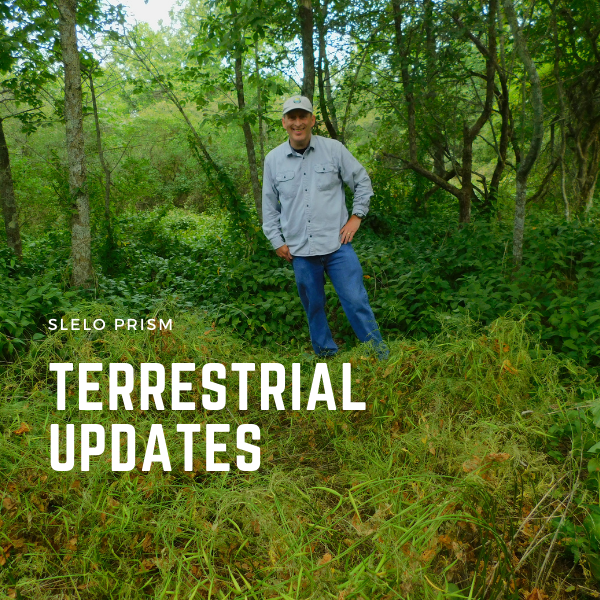This article was featured in the 2022 summer newsletter by Robert Smith-SLELO PRISM.
Giant Hogweed Eradication Efforts:
Giant hogweed management has been completed for this year. Of the 44 sites in que, 27 had no germination with four of the sites being giant hogweed free for 9 years and retired. 15 of these sites were found to have Giant hogweed. Four of those sites were treated using the root cut method and 11 were treated using a foliar application. Permission was not granted at 2 sites. We also have eighteen sites that were not due for long-term monitoring (6 or 9 years giant hogweed free). The total sites that SLELO PRISM is currently responsible for are 62.

Biological Control of Emerald Ash Borer: This year, we were approved by the USDA to release EAB biocontrol insects at Rice Creek Field Station (SUNY Oswego). As part of this USDA program, the releases will occur for two years. This year, we are scheduled for 8 releases from June-August. The type of biocontrols being released are parasitoid wasps, and the USDA is providing us with 3 species of these wasps (Spathius galinae, Tetrastichus planipennisi, and Oobius agrili). O. agrili targets EAB eggs, while S. galinae and T. planipennisi target EAB larvae. Depending on the species and stage of life, these species are released using oobinators (pupae), bolts (pupae), or cups (adults). Dispersal of these wasps is conducted by SLELO PRISM with the assistance of staff from Rice Creek Field Station and the Oswego County Soil & Water Conservation.
Each release is occurring in different sections of the release area to promote an even distribution of the biocontrol wasps. Information about the release area, species/life stage released, and condition of release trees is recorded in the USDA’s Biocontrol App. (MapBioControl). So far, we have conducted four releases with four more releases scheduled. Total parasitoid wasps released by species are as follows: 1838 T. planipennisi, 581 S. galinae, and 600 O. agrili.


Other Biocontrol Updates
Swallowwort Biocontrol:
We currently have four cages for Hypena opulenta moths- the biocontrol for swallow- wort. Two of the cages are at Robert Wehle State Park, and the other two are at Grenadier Island. These moths have been in the cages for about 6 weeks. The numbers of larvae produced, much like last year, were low, and defoliation in all cages is at less than 5%. They are currently pupating, and we plan to retain them in the cages to emerge as adults and produce a new generation of larvae. This worked very well on Grenadier Island last year. I conducted an overwintering survey this year but could not find evidence of Hypena’s presence. I am currently working with the residents of Grenadier Island to show them what to look for, so they can report photos of the presence of H. opulenta adults or signs of swallow-wort defoliation.

Hemlock Woolly Adelgid (HWA):
We plan to release HWA biocontrol next year at Independence Park (Oswego County). There are three species of insects that are used for HWA. These are a beetle (Laricobius nigrinus) and silver flies (Leucopis argenticollis and Leucopis piniperda). The biocontrol insects will be provided to us by the New York State Hemlock Initiative. We are currently waiting for approval from Oswego County to release these biocontrol insects.
Purple Loosestrife:
There are two species of beetles (Galerucella calmariensis and Galerucella pusilla) that have been used for many years for purple loosestrife. We plan to collect these beetles in the field and release them at PCAs where there is a high density of purple loosestrife.


2022 Early Detection Surveys
The 2022 Early Detection Surveys are currently in progress. We have 9 Priority Conservation Areas (PCAs) to conduct both aquatic and terrestrial surveys. This will require us to survey approximately 123 highly probable areas, 47 of
these have active treatments occurring and we will be evaluating these for post treatment success. We are also conducting native species surveys at these PCAs to get a better idea of what species we are protecting and to integrate into a PCA scoring system that we are working on.


Spotted Lanternfly Traps:
This year, the NYS Department of Agriculture and Markets provided us with 10 spotted lanternfly (SLF) traps. SLF is a tier 1 species in the SLELO PRISM, so it has not been observed in the area to date. It has been found in the downstate, southern tier region, including Ithaca and was originally found in PA. It feeds on more than 70 plant species including maples, apples, oaks, grapes, hops, so its agricultural impact could be quite large if it were to arrive. Spotted lanternfly is a hitchhiking pest and lays eggs on many different surfaces, including vehicles, trailers, and outdoor equipment. This allows it to spread long distances when people move infested equipment. These traps will be checked every two weeks through October.



